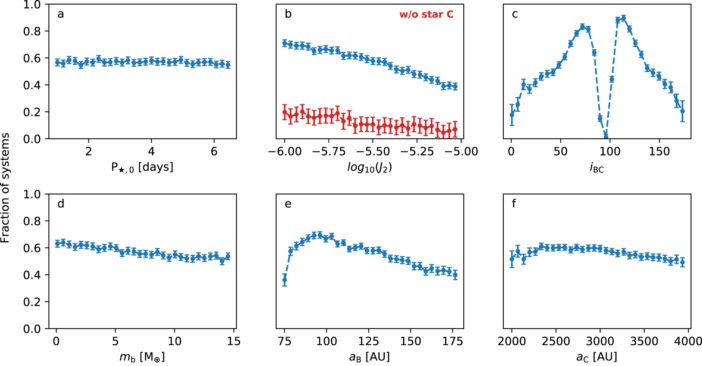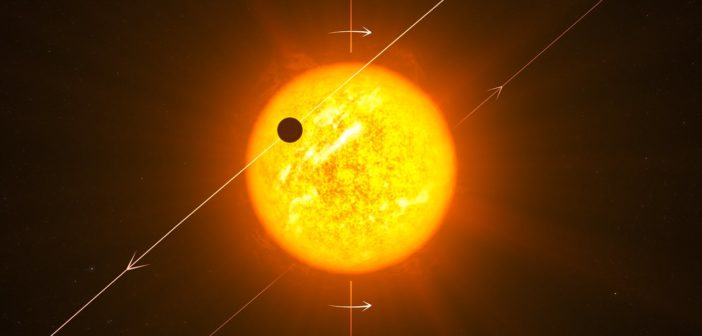Editor’s note: Astrobites is a graduate-student-run organization that digests astrophysical literature for undergraduate students. As part of the partnership between the AAS and astrobites, we occasionally repost astrobites content here at AAS Nova. We hope you enjoy this post from astrobites; the original can be viewed at astrobites.org.
Title: The Chaotic History of the Retrograde Multi-planet System in K2-290A Driven by Distant Stars
Authors: Sergio Best and Cristobal Petrovich
First Author’s Institution: Pontifical Catholic University of Chile
Status: Published in ApJL
Most planets orbit their stars in the same direction the stars spin. Why are some rare systems misaligned?
The K2-290 triple star system hosts a pair of planets with seriously misaligned orbits. Planets b and c orbit the system’s central star — K2-290A — with an obliquity (relative tilt) of 124° from their host star’s spin axis. An obliquity of greater than 90° is considered retrograde, as the planets move opposite the direction that the star spins.
A previous study concluded that this tilt was caused by interactions between star A and its stellar companion, star B, while star A’s planetary system was still in the protoplanetary disk phase of development. In this scenario, the disk was knocked out of alignment when the planets were in resonance with star B, when the closest or farthest orbital points align. However, as the authors of this earlier work stated, “there may be more than one way to misalign a disk.” Today’s article explores another possible cause of this misalignment involving the system’s third stellar member, K2-290C.

Figure 1: Diagram of the K2-290 system (distances not to scale). The two planets share an orbital plane, which is inclined ~124° relative to star A’s spin axis. The distant stellar companions have some unknown mutual inclination relative to one another (labeled iBC on this diagram). Stellar distances are projected onto the observable plane of the system from Earth, at some unknown inclination, meaning that the orbital separations may be larger by some unknown factor. [Best & Petrovich 2022]
How to Misalign Your Planet
The authors of today’s article simulated the interactions between the five bodies in the K2-290 system to see what sort of initial conditions would result in the strange alignment observed today. When more than two bodies interact gravitationally, dynamical systems can be quite chaotic. When a distant third star (C, in this case) orbits a closer binary pair (A and B) at an angle, it can cause the inner binary pair’s orbital eccentricity and inclination to oscillate through a three-body interaction called the Zeipel-–Kozai–Lidov mechanism. These oscillations provide a possible mechanism for planetary orbit misalignment.
When star B is on a highly elongated orbit, it causes the planets’ orbital precession (slow tilting of spin axis) to change in frequency, knocking them out of star A’s equatorial plane. With star C in the picture to mess with star B’s orbit, a wide array of initial conditions can lead to this strongly misaligned end result.

Figure 2: The fraction of systems with initial conditions that result in planetary orbits with an obliquity of ~124°. These panels examine star A’s initial spin period, star A’s quadrupole moment (deviation from spherical shape), the mutual inclination of stars B and C, planet b’s mass, star B’s semi-major axis, and star C’s semi-major axis. The red points illustrate how simulations without star C don’t create the observed misalignment for reasonable estimations of star A’s internal structure. [Best & Petrovich 2022]
So, what really happened in the K2-290 system? Ultimately, the authors show that star C’s influence could cause the observed retrograde planetary orbits seen around K2-290A. Does this mean that previous findings about primordial misalignment in K2-290A’s protoplanetary disk is wrong? No, but it shows that it isn’t a requirement to get this result when a third star is in play.
Some unanswered questions about this system remain. So far, K2-290A is only known to host two planets, but its radial-velocity measurements show that another planet with a longer orbital period is possible and could increase the level of interaction between the planets and star B. Putting better constraints on the orbits of stars B and C could further test this dynamical theory.
What Does This Mean for Other Planetary Systems?
K2-290 was the first system found to present strong evidence of primordial disk misalignment, with star B at the right distance to cause the theorized effect. But, considering star C, these large obliquities can form after the protoplanetary disk phase from a wide array of different initial conditions. The primordial misalignment theory depends on some highly uncertain gas dynamics and evaporation, while the components of the tertiary-driven mechanism presented in today’s article are physically pretty well understood. The two mechanisms could work together in some systems since the mechanism presented in this article is not highly dependent on the initial configuration of the system.
This 124° obliquity is not particularly special; this mechanism could drive systems all the way to 180° — a perfectly retrograde orbit. Additionally, in other systems, a Jupiter-sized planet at a tenth of the distance of star B could mimic star B’s effect, helping to drive the misalignment of inner planets. It’ll be fascinating to see what sorts of weird misaligned systems exoplanet hunters find next!
Original astrobite edited by Roan Haggar.
About the author, Macy Huston:
I am a fourth-year graduate student at Penn State University studying astronomy and astrophysics. My current work focuses on technosignatures, also referred to as the Search for Extraterrestrial Intelligence (SETI). I am generally interested in exoplanet and exoplanet-adjacent research. In the past, I have performed research on planetary microlensing and low-mass star and brown dwarf formation.

